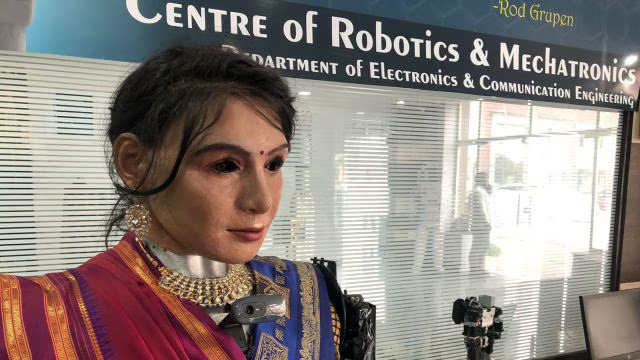
When the majority of fans of science fiction consider humanoid machines, they usually picture anything from an Isaac Asimov book or a terrifyingly lifelike character like Dolores from the TV show Westworld. The development of generative AI and the presence of social robots like Hanson Robotics’ Sophia suggest that fully fledged robots are not too far off in the future. However, getting there can be just as exciting as the adventure itself. My decision to decline the chance to engage with a humanoid robot developed in a small lab on an engineering college campus buried away in the middle of India was difficult because of this.
I was both apprehensive and thrilled to meet Anushka, the humanoid robot created by a group of instructors and students at the Krishna Institute of Engineering and Technology (KIET) in Ghaziabad, Uttar Pradesh. The main purposes of Anushka as she exists now are to welcome guests and respond to their enquiries with relevant data. Anushka’s developers, however, see more for her than just a robotic secretary; they see possibilities for her in the consulting and medical fields. Anushka caused quite a stir when she was originally shown in March 2024, supposedly being the first humanoid robot to be constructed in north India with independent locomotion. A few eyebrows were also raised by the assertion that she was created with consideration for Vedic concepts.
As I walked into the lab, I saw Anushka attached to a monitor next to a table covered in 3D printed components and microcontrollers. The robot was created on a budget of Rs 2 lakh, according to Dr. Manoj Goel, joint director of KIET. This is a small amount of the Rs 7-8 crore often required to make humanoid robots. He informed me that some parts were even obtained from a nearby landfill.
Anushka’s elastic silicone body was created by Madame Tussauds in India, while parts of her face are 3D printed. Notably, generative AI was used to further improve her facial characteristics, which were patterned after those of a deceased French royal. It took around a year and a half to finish the full job.

Autonomy in humanoid robots
Since Artificial General Intelligence (AGI) has not yet been attained, humanoid robots like as Anushka cannot be truly said to be aware of themselves. However, that does not imply that she is not intelligent at all.
“Here, artificial intelligence functions in four stages: listening, observing and comprehending your image through computer vision, utilising natural language processing to converse with you in the third stage, and finally, commanding the servo motors to operate in unison. The team stated that each degree of intelligence is essential because when combined, they guarantee that everything runs properly.
The “Spooky Valley” phenomenon
Creating realistic-looking humanoid machines surely presents a number of technical problems for scientists and engineers. But the uncanny valley presents an ethical conundrum that they could have to face. The unsettling sensation you get when you encounter a robot that almost exactly resembles a human is known as the “uncanny valley.” Gizmodo reported that the term was first used to describe the decrease in audience likability that occurred when a humanoid robot or computer-generated figure appeared on display.
Because of her enhanced humanoids’ ability to express, Sophia may find herself in an uncanny valley where she virtually seems human. This could undermine the credibility of actual people and defeat the goal of social robots. Theoretically, movies or photos of individuals produced by AI may potentially elicit the same unsettling, spooky sensation.
- August 12, 2024
- By:A A
- Categories:Blog
- Tags: Artificial Intelligence, Machine Learning
- no comments

Post a Comment